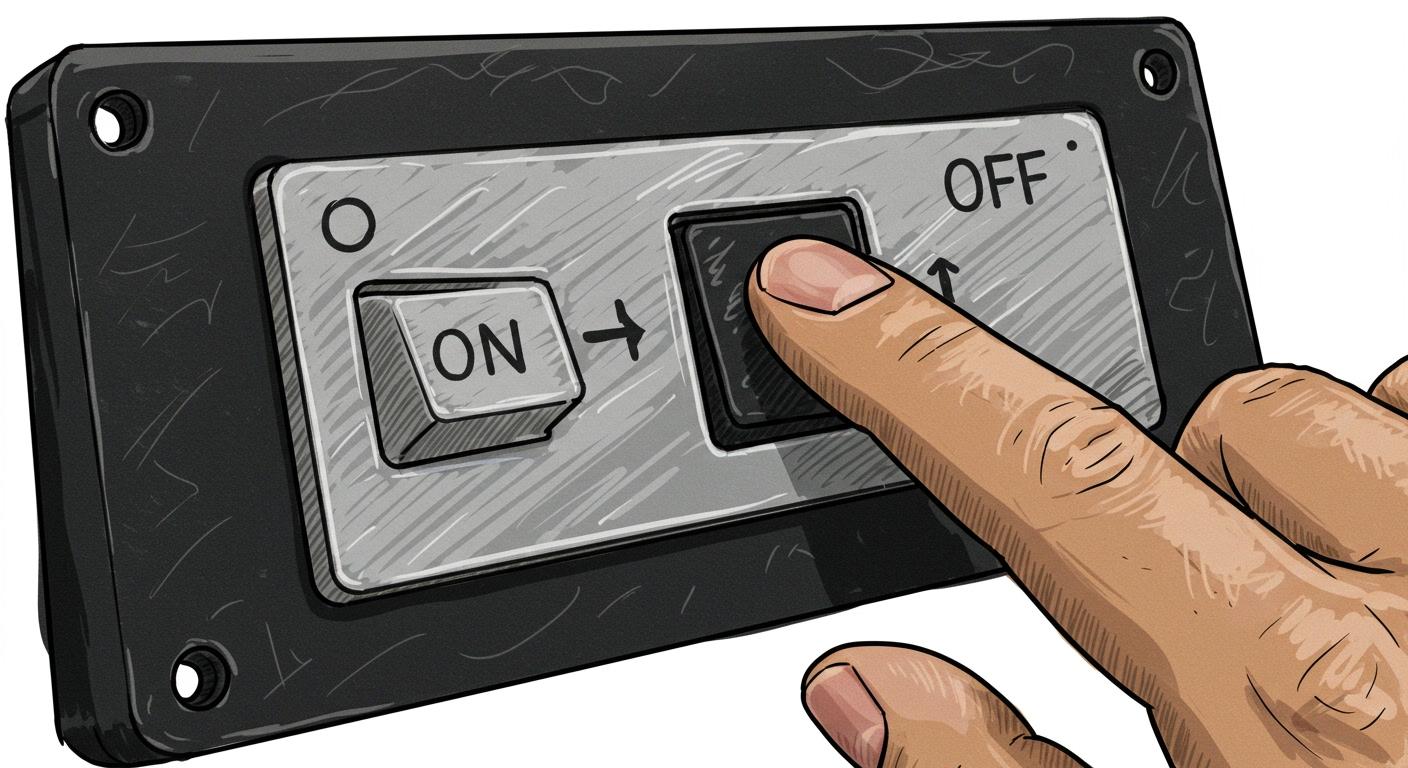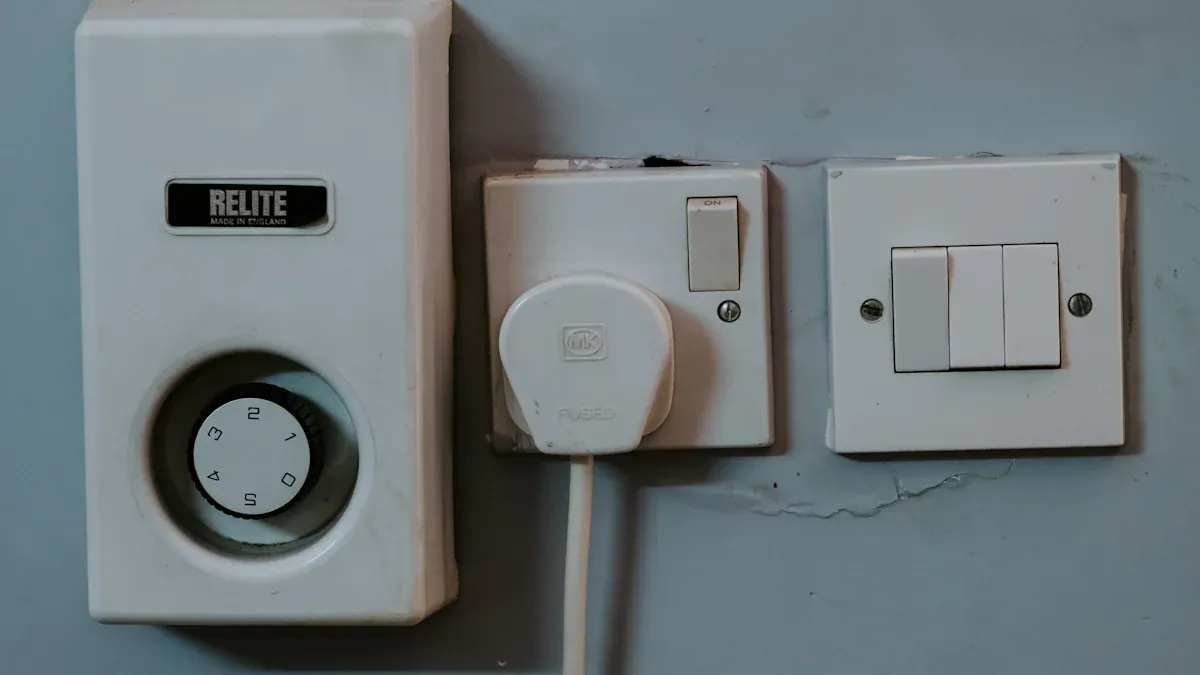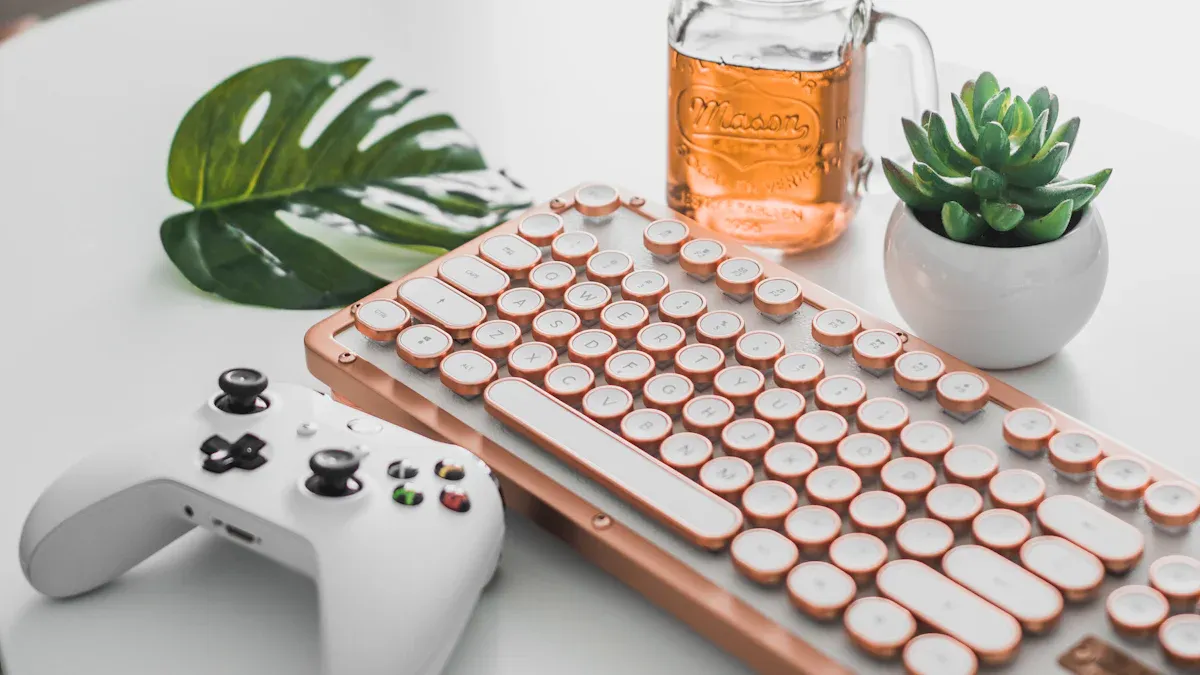
What is an On Off Membrane Switch and How Does It Work
What is an On Off Membrane Switch and How Does It Work

An on off membrane switch gives you a simple way to control electronic devices. When you press the switch, you complete or break an electrical circuit, turning the device on or off. This membrane switch acts as the main user interface, providing a clear, reliable interface for many products.
- The membrane switch market size is projected to grow from $7.93 billion in 2024 to $8.69 billion in 2025, showing rapid adoption in various industries.
Key Takeaways
- An on off membrane switch controls devices by completing or breaking an electrical circuit with a simple press.
- These switches are durable and sealed, protecting against dust and moisture, making them ideal for medical and industrial applications.
- Customization options allow for tailored designs, including graphics and tactile feedback, enhancing user experience and brand identity.
- Membrane switches are cost-effective for large-scale production, providing significant savings while maintaining high performance.
- With a lifespan of 5 to 10 million presses, membrane switches offer reliable operation in demanding environments.
On Off Membrane Switch Basics
What Is a Membrane Switch
You interact with a membrane switch every time you press a flat, flexible button on a modern device. This switch uses thin layers of flexible material, such as polyester or polycarbonate, to create a low-profile interface. Unlike traditional mechanical switches, which use hard plastic and copper, a membrane switch relies on printed conductive inks on materials like PET or ITO. This design makes the switch lightweight, cost-effective, and highly durable.
Membrane switches stand out because they offer a sealed surface that protects internal components from dust, moisture, and contaminants. You often find them in environments where cleanliness and reliability matter. The switch can be customized with different graphics, colors, and shapes, making it suitable for a wide range of applications. Whether you use a microwave, medical device, or industrial control panel, you benefit from the versatility and adaptability of membrane switches.
You can choose between tactile and non-tactile membrane switches, each offering unique features. The table below highlights the differences:
| Feature | Tactile Switches | Non-Tactile Switches |
|---|---|---|
| Physical Response | Provides a tactile response when pressed | No physical response when pressed |
| Construction | Made with stainless steel, polydome, or hydro-form domed overlay | Printed with a conductive pad on the bottom side of the overlay |
| Activation Mechanism | Metal dome compresses to connect to the circuit | Conductive pad connects to the circuit when the overlay is pressed |
| Durability | Can be activated up to a million times | Can be activated up to five million times |
| Environmental Sealing | Internally vented and sealed to prevent contamination | Self-contained unit, typically not sealed from the environment |
You notice that membrane switches differ from mechanical switches in both construction and function. Their printed design allows for more affordable production and greater durability, especially in demanding applications.
How It Works
When you press an on off membrane switch, you trigger a precise sequence of electrical events. The switch consists of several thin layers, including a top graphic overlay, a spacer, and a bottom circuit layer. The top layer flexes under your finger, causing a conductive dome or pad to touch the bottom contact. This action completes the circuit and sends a clear signal to the device.
The electrical principles behind membrane switches ensure reliable performance and long life. Here is how the core functionality works:
- Membrane switches rely on precise electrical design to deliver clear signals and extend lifespan.
- Conductive traces act as essential pathways for electrical current. These traces must have low resistance, typically under 100 ohms, to minimize power loss.
- Contact points play a critical role in making connections. The gap between contacts must be carefully controlled to prevent connection failures.
- The assembly endures thousands of presses, so manufacturers use durable materials and advanced engineering.
- When you press a key, the top layer flexes, allowing the conductive dome to touch the bottom contact. This action completes the circuit and ensures fast signal transmission.
You experience immediate feedback and reliable operation every time you use a membrane switch. The absence of moving parts reduces wear and tear, which increases the switch’s lifespan. This design also allows for easy cleaning and maintenance, making membrane switches ideal for many applications.
Membrane switches provide a user-friendly interface for controlling devices. Their simple yet effective construction ensures consistent functionality, whether you need to turn a device on or off or navigate complex menus.
Construction of Membrane Switches

Key Layers
When you explore the anatomy of a membrane switch, you discover a sophisticated structure designed for durability and performance. Each membrane switch contains several distinct layers, each serving a specific function. The most common configurations include four-layer and six-layer structures. You can compare their advantages and drawbacks in the table below:
| Structure Type | Advantages | Drawbacks |
|---|---|---|
| Six-Layer | Enhanced durability, Improved tactile feedback | Increased complexity, Thickness |
| Four-Layer | Simplicity, Thin profile | Limited durability |
The graphic overlay forms the top layer, providing the visual interface and protecting the underlying components. Beneath this, the adhesive layer secures the overlay to the spacer layer, which separates the circuit from the overlay and ensures precise actuation. The circuit layer contains conductive ink traces that carry electrical signals. The backer layer supports the entire assembly, while the dome switch delivers tactile feedback. You benefit from this layered design because it shields the membrane switch from dust, moisture, and contaminants.
Materials and Customization
You encounter a variety of materials in membrane switches, each chosen for its unique properties. The most common materials include:
- Polyester and polycarbonate for the graphic overlay
- Acrylic adhesive for the adhesive layer
- Polyester for the spacer layer
- Conductive ink, such as silver or carbon, for the circuit layer
- Polyester for the backer layer
- Stainless steel or polyester for the dome switch
These materials contribute to the reliability and longevity of every membrane switch. You can customize membrane switches to fit your specific needs. You may select colors, shapes, and button arrangements that match your brand or application. You can request tactile or non-tactile feedback, depending on your preference. Some membrane switches feature LED indicators for status signaling, while others mount on or recess into carrier plates made of aluminum, stainless steel, or plastic. You can choose finishes like anodized or brushed surfaces for added appeal.
Manufacturers face challenges such as poor touch sensitivity, air bubbles, fading coatings, and circuit failures. You ensure quality by demanding repeated testing cycles, tactility assessments, and durability evaluations. When you select a membrane switch, you gain a user interface that combines advanced engineering with tailored design.
Operation and Features
On/Off Mechanism
You activate an on off membrane switch by pressing its surface. This action pushes the top layer down until it touches the bottom circuit layer. When the two conductive surfaces meet, the circuit closes, and the device turns on. Releasing your finger breaks the connection, turning the device off. This simple process gives you precise control over the device’s functionality. The membrane switch design eliminates bulky moving parts, which improves performance and reduces the risk of mechanical failure. You benefit from a clean, sealed interface that keeps out dust and moisture, making it ideal for many applications.
Tactile Feedback
Tactile feedback plays a key role in the user experience of membrane switches. When you press a button, you feel a slight snap or click. This feedback confirms that you have activated the switch. You gain confidence in your input, especially in environments where accuracy matters. Tactile feedback offers several advantages:
- It enhances user experience by providing clear physical responses to interactions.
- It increases accuracy in user inputs, especially in precision-critical industries.
- The feedback fosters a sense of control and trust in the device, leading to improved user satisfaction.
Membrane switches achieve this feedback without traditional moving parts. This design choice boosts durability and reliability, ensuring consistent performance over time.
Reliability
You can rely on membrane switches for long-term performance in demanding environments. The absence of exposed moving parts means less wear and tear. Manufacturers test these switches for millions of cycles to guarantee durability and reliability. The table below compares the typical lifespan of membrane switches and mechanical switches:
| Switch Type | Lifespan (Keystrokes) |
|---|---|
| Membrane Switches | 5 to 10 million |
| Mechanical Switches | Over 100 million |
In industrial applications, membrane switches often meet strict standards for safety and quality. Common certifications include:
| Certification | Description |
|---|---|
| UL 508 | Ensures safety and performance standards for industrial control equipment. |
| ISO 9001 | Focuses on quality management systems and continuous improvement processes. |
| RoHS | Restricts hazardous substances in electrical and electronic equipment. |
| IPC/WHMA-A-620 | Addresses workmanship quality for flexible printed circuits, ensuring best practices in production. |
| UL 61010 | Ensures safety and performance standards for electrical equipment used in industrial settings. |
You can trust membrane switches to deliver reliable performance and maintain functionality across a wide range of applications.
Applications of Membrane Switches

Membrane switches play a vital role in many industries due to their adaptability and robust design. You encounter these switches in a wide range of products, each with unique application requirements. The applications of membrane switches extend from everyday gadgets to specialized industrial systems.
Consumer Electronics
You interact with membrane switches daily in consumer electronics. Devices such as remote controls, microwave ovens, and washing machines rely on these switches for reliable operation. Manufacturers often customize the interface to support accessibility features. For example:
- Tactile feedback helps users with visual impairments locate and operate controls.
- Large buttons make devices easier to use for individuals with motor impairments.
- Custom graphics and layouts enhance usability and brand identity.
These features ensure that the membrane switch meets the needs of a diverse user base while maintaining consistent functionality.
Medical Devices
In medical environments, hygiene and safety are critical. You find membrane switches in equipment like infusion pumps, diagnostic machines, and patient monitors. Their design supports strict hygiene standards:
- Fully sealed surfaces protect against fluids and contaminants.
- Smooth overlays allow for easy cleaning and sanitization.
- Materials resist chemicals, UV radiation, and abrasion.
- Layered construction ensures waterproofing and sterilization compatibility.
- Compliance with ISO 13485 and IEC 60601 standards guarantees safety and quality.
These properties make membrane switches ideal for medical applications where reliability and cleanliness are essential.
Industrial Equipment
Industrial settings demand durable and spill-resistant interfaces. You see membrane switches in control panels, machine interfaces, and automation systems. The table below highlights common industrial equipment types:
| Industrial Equipment Types | Description |
|---|---|
| Factory Automation Systems | Use membrane switches for control interfaces. |
| Robotics | Rely on membrane switches for user interaction. |
| Process Controls | Benefit from rugged, spill-resistant designs. |
Membrane switches withstand harsh conditions and frequent use, making them a preferred choice for industrial applications.
Other Applications
You also find membrane switches in security systems, instrumentation, and specialized equipment. These switches offer:
- Protection from electrostatic discharge.
- Enhanced performance with LED illumination and tactile feedback.
- Customization to meet FDA standards and moisture resistance for medical and industrial uses.
The versatility of membrane switches allows you to tailor them for nearly any application, ensuring they meet specific industry needs and application requirements.
Tip: The wide range of applications of membrane switches demonstrates their value in both standard and highly specialized environments.
Advantages of Membrane Switches
Durability
You can count on a membrane switch to perform reliably in harsh environments. Manufacturers use advanced materials like polyester and polyimide, which resist chemicals, moisture, and extreme temperatures. Protective coatings and seals keep out dust and contaminants, so the switch lasts longer even in challenging conditions. The table below highlights the main factors that contribute to durability:
| Factor | Description |
|---|---|
| Construction | Built from a single, flexible layer, reducing mechanical failure risks. |
| Material Quality | Polyester or polyimide enhances resistance to chemicals, moisture, and temperature extremes. |
You benefit from a sealed design that prevents water and chemical ingress. This feature ensures the membrane switch maintains high reliability and consistent performance. In industries like oil and gas, these switches withstand vibration and impact, minimizing downtime and maintenance costs. The benefits of membrane switches include exceptional durability and the ability to operate in a wide temperature range.
Design Flexibility
A membrane switch offers you unmatched design flexibility. You can customize graphics, button layouts, and even add LED indicators for status feedback. Modern production techniques allow precise printing of logos and symbols, which improves branding and usability. However, you should know that membrane keyboards have integrated keycaps, so you cannot swap out switches or personalize keycaps as you would with mechanical switches.
Note: The slim profile and customizable graphics make membrane switches ideal for compact devices and branded equipment.
The benefits of membrane switches extend to easy cleaning and the ability to seal the interface for medical or industrial use. You can tailor the switch to fit your specific application, whether you need a waterproof surface or a unique button arrangement.
Cost-Effectiveness
You gain significant cost savings when you choose a membrane switch for large-scale manufacturing. Volume production lowers the cost per unit, making these switches economical for medium-to-high volume projects. The benefits of membrane switches include material efficiency and scalable production, which further reduce expenses. In regions like Asia-Pacific, economies of scale drive down costs even more.
- Large-scale production reduces per-unit costs.
- Material efficiency and scalable processes maximize savings.
- Economical for high-volume applications.
The table below summarizes key advantages:
| Advantage | Description |
|---|---|
| Cost-Effective | Ideal for medium-to-high volume production. |
| Slim Profile | Fits compact or low-profile equipment. |
| Ease of Cleaning | Flat surface resists dirt and is easy to wipe down. |
You also benefit from energy-efficient options, such as LED backlighting, which lowers power consumption and reduces environmental impact. These features make membrane switches a smart choice for both your budget and sustainability goals.
You now understand that an on off membrane switch gives you a reliable, compact way to control electronic devices. Its construction includes layers such as a graphic overlay, spacer, adhesive, metal dome, flexible circuit, and support, all working together to deliver precise operation and tactile feedback. When you press the surface, the circuit closes, allowing for simple and effective user interaction. You benefit from a membrane switch because it offers durability, customizability, and cost-effectiveness. These switches power everything from medical equipment to consumer electronics. Their slim design, minimal maintenance, and proven performance in demanding environments make them essential in modern technology. You can trust an on off membrane switch to provide dependable control and versatility for your devices.
FAQ
What is the lifespan of an on off membrane switch?
You can expect a membrane switch to last between 5 and 10 million actuations. Manufacturers test these switches for durability, making them suitable for high-use environments like medical devices and industrial controls.
Can you clean a membrane switch easily?
You can clean a membrane switch with a soft cloth and mild detergent. The sealed surface resists moisture and dust, which helps maintain hygiene in medical and food processing settings.
Are membrane switches customizable for my device?
You can request custom graphics, colors, shapes, and button layouts. Manufacturers offer options like LED indicators, tactile feedback, and waterproofing to match your specific application requirements.
Do membrane switches provide tactile feedback?
You feel a distinct snap or click when you press a tactile membrane switch. This feedback confirms activation and improves user confidence, especially in environments where accuracy matters.
What industries use on off membrane switches?
You find membrane switches in consumer electronics, medical devices, industrial equipment, and security systems. Their versatility and reliability make them ideal for many applications.

Top Membrane Switches for Home Electronics Projects in 2025
You can elevate your home electronic membrane switch project in 2025 with standout models such as the 4×4 Matrix 12 Keys Keypad from SOUSHINE, the rgb-enabled strip switches from Molex, and custom graphic switches by Panasonic. These switches offer slim profiles and reliable performance, making them easy to integrate into your DIY setup. You gain ...

Top tips for fixing PS4 controller conductive film keypads
Are you frustrated because your PS4 controller buttons have stopped working? You are not alone. Many gamers experience issues with the conductive film keypad for ps4. Button failures often happen because of dirt, debris, or rough handling. Take a look at the most common causes: Cause Description Dirt and debris Accumulation in button crevices can ...

Top Membrane Switch Companies Leading the Industry in 2025
You see a dynamic market shaping the future of membrane switch technology. Leading companies like Molex, SOUSHINE, YU AN Electronics, TE Connectivity, Honeywell, Omron, Mitsubishi Electric, Panasonic, Industrial Print Technologies, SCHURTER, XYMOX, Douglas Corp, Dyna-Graphics, ELO Touchscreens, UTC, LUNFENG Technology, and Fujikura drive growth with innovation and global reach. Choosing the right membrane switch company ...
Contact us online